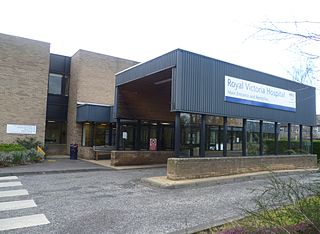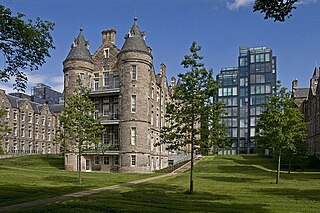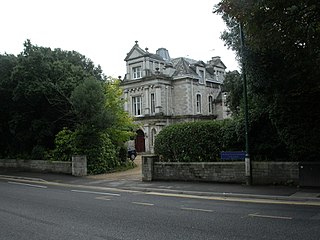
The Royal Victoria Hospital was a health facility at Craigleith Road in the north-west of Edinburgh, Scotland. It was formerly the main Medicine for the Older Adult assessment and rehabilitation hospital for the north of Edinburgh. It closed in 2012, then briefly reopened to ease pressure on acute beds in the region. The facility finally closed in early 2017 and was not in use when a fire caused damage to buildings in May 2017. It was managed by NHS Lothian.

The Royal Infirmary of Edinburgh (RIE), often known as the Edinburgh Royal Infirmary (ERI), was established in 1729 and is the oldest voluntary hospital in Scotland. The new buildings of 1879 were claimed to be the largest voluntary hospital in the United Kingdom, and later on, the Empire. The hospital moved to a new 900 bed site in 2003 in Little France. It is the site of clinical medicine teaching as well as a teaching hospital for the University of Edinburgh Medical School. In 1960, the first successful kidney transplant performed in the UK was at this hospital. In 1964, the world's first coronary care unit was established at the hospital. It is the only site for liver, pancreas and pancreatic islet cell transplantation and one of two sites for kidney transplantation in Scotland. In 2012, the Emergency Department had 113,000 patient attendances, the highest number in Scotland. It is managed by NHS Lothian.

Queen Elizabeth Hospital is a hospital in Woolwich in the Royal Borough of Greenwich. It was opened in March 2001 and serves patients from the Royal Borough of Greenwich and the London Borough of Bexley. The hospital was built to accommodate the services previously provided at Greenwich District Hospital and Brook General Hospital, and is a Private Finance Initiative hospital. It is managed by the Lewisham and Greenwich NHS Trust.

Lauriston is an area of central Edinburgh, Scotland, and home to a number of significant historic buildings. It lies south of Edinburgh Castle and the Grassmarket, and north of The Meadows public park.

The Edinburgh Royal Maternity and Simpson Memorial Pavilion was a maternity hospital in Lauriston, Edinburgh, Scotland. Its services have now been incorporated into the Royal Infirmary of Edinburgh at Little France.

NHS Lothian is one of the 14 regions of NHS Scotland. It provides healthcare services in the City of Edinburgh, East Lothian, Midlothian and West Lothian council areas. Its headquarters are at Waverley Gate, Edinburgh

The Royal National Throat, Nose and Ear Hospital was a health facility on Gray's Inn Road in London. It closed in October 2019 when services transferred to the new Royal National ENT and Eastman Dental Hospitals on Huntley Street, London, WC1E 6DG. The Huntley Street hospital continues to provide specialist ENT, sleeps and allergy services and is part of University College London Hospitals NHS Foundation Trust.

The Royal Alexandra Hospital (RAH) is the main hospital in Paisley serving a large catchment area stretching all the way to Oban and Argyll. The hospital is managed by NHS Greater Glasgow and Clyde.

University Hospital Lewisham is a teaching hospital run by Lewisham and Greenwich NHS Trust and serving the London Borough of Lewisham. It is now affiliated with King's College London and forms part of the King's Health Partners academic health science centre. It is situated on Lewisham High Street between Lewisham and Catford.

The Royal Lancaster Infirmary (RLI) is a hospital in the city of Lancaster, England. It lies to the south of the city centre, between the A6 road and the Lancaster Canal. It is managed by the University Hospitals of Morecambe Bay NHS Foundation Trust.

The Leith Community Treatment Centre is a community hospital in Junction Place, Leith, Edinburgh, Scotland. It is managed by NHS Lothian.

The Astley Ainslie Hospital is a community hospital in The Grange, Edinburgh, Scotland. It is operated by NHS Lothian.

The Lauriston Building is an out-patient centre in Lauriston, Edinburgh, Scotland. It is managed by NHS Lothian.

Edinburgh BioQuarter is a key initiative in the development of Scotland's life sciences industry, which as of August 2020 employs more than 39,000 people in over 750 organisations.

The Royal Waterloo Hospital for Children and Women was a hospital located on the corner of Waterloo Bridge Road and Stamford Street near Waterloo station in London, England. The current building was designed by noted ecclesiastical architect Sir Charles Nicholson at a cost of £45,000 and included an outpatients' department and inpatient accommodation of 90 beds. The hospital closed in 1981 and is now a dormitory building for the London branch of the University of Notre Dame.

The Royal Victoria Hospital was a hospital situated on two sites in Bournemouth, England. The primary site was in Boscombe but for a period of time it was merged with a Westbourne site. The Westbourne site was the first named Royal Victoria Hospital of the two but the name was applied to both sites after merger in 1911. It has had several name changes during its history.

George Ian Scott CBE, FRSE, FRCSEd was a 20th-century Scottish ophthalmic surgeon who in 1954, became the first holder of the Forbes Chair of Ophthalmology at the University of Edinburgh. He specialised in neuro-ophthalmology, studies of the visual fields and diabetic retinopathy. He was President of the Royal College of Surgeons of Edinburgh from 1964 to 1967, Surgeon-Oculist to the Queen in Scotland from 1965 and president of the Ophthalmological Society of the United Kingdom from 1970 to 1972.

The Edinburgh City Hospital was a hospital in Colinton, Edinburgh, opened in 1903 for the treatment of infectious diseases. As the pattern of infectious disease changed, the need for in-patients facilities to treat them diminished. While still remaining the regional centre for infectious disease, in the latter half of the 20th century the hospital facilities diversified with specialist units established for respiratory disease, ear, nose and throat surgery, maxillo-facial surgery, care of the elderly and latterly HIV/AIDS. The hospital closed in 1999 and was redeveloped as residential housing, known as Greenbank Village.




















